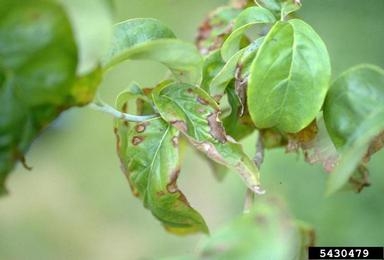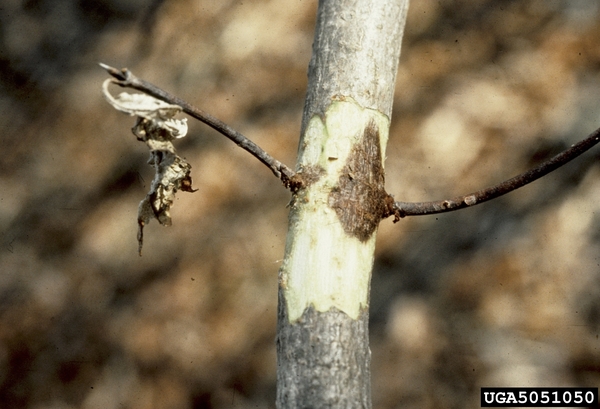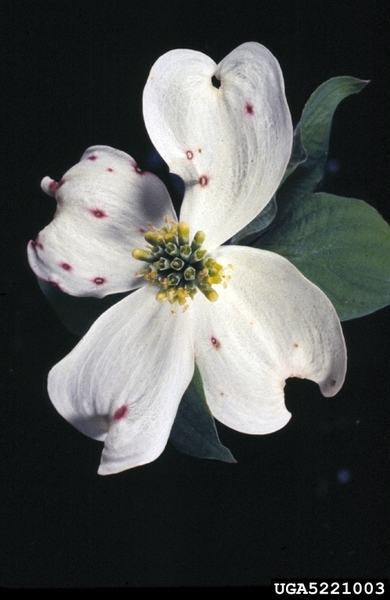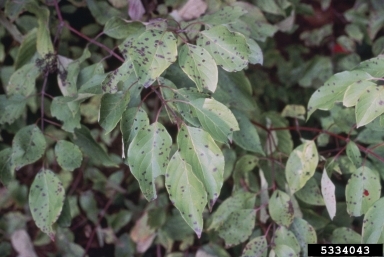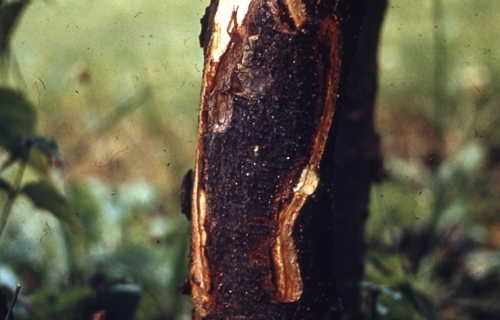Introduction
Dogwoods are beloved trees in North Carolina. The showy white flowers of flowering dogwood (Benthamidia florida) are a welcome sign of spring and became the state flower in 1941. Many choose to plant dogwoods in their landscapes, as well, so recognizing dogwood pests and having accessible management resources are important in managing this beautiful landscape or forest tree.
Dogwood Anthracnose
Dogwood anthracnose (caused by Discula destructiva) is the most serious disease of dogwood trees in the southern US and has only been detected in western NC. The pathogen was introduced from Asia to the US accidentally in the 1970s and has caused extensive mortality of native dogwood trees throughout the eastern US. Flowering dogwood (Benthamidia florida) and Pacific dogwood (B. nuttallii) are most susceptible to this disease, while Kousa dogwood (B. japonica), silky dogwood (Swida amomum), and alternate-leaf dogwood (S. alternifolia) are fairly resistant. The first symptoms of this disease include small tan spots on leaves with a purple border between dead and healthy tissue. The spots may affect the entire leaf and cause them to either drop or persist on the tree as dead leaves. During flowering, floral bracts may also have these spots. Eventually, fungal growth spreads to petioles and twigs, causing large cankers. Twigs begin to have tan to brown blotches, which can girdle the entire twig or branch. The pathogen overwinters in cankers and dead leaves that persist on the branches. This disease is very difficult to control and manage, but pruning off infected branches can be important to increase air flow in the canopy. Additionally, using resistant species and cultivars in ornamental settings is crucial in preventing the spread of this pathogen. This serious disease is different from spot anthracnose, a ubiquitous and aesthetic concern only. More information about dogwood anthracnose can be found from the USDA Forest Service.
Spot Anthracnose
Spot anthracnose, or dogwood spot anthracnose (caused by Elsinoe corni), is a common fungal disease of flowering dogwood (B. florida) and other susceptible dogwood species. Symptoms include small spots on the leaves and/or flower bracts with a red to purple border. It tends to spread more quickly and severely in years with high rainfall, as high-moisture environments favor fungal growth. This disease is frequently confused with dogwood anthracnose, a more serious disease caused by Discula destructiva. Spot anthracnose idoes not spread to branches. Because the severity of the disease depends on rainfall, fungicide is generally not recommended. Trees can be pruned ot increase airflow and reduce moisture longevity and fallen leaves should be removed and destroyed in the fall. More information about spot anthracnose can be found from Clemson Cooperative Extension.
Cercospora Leaf Spot
Cercospora leaf spot (Cercospora spp.) can affect a variety of dogwood species during wet and humid summers. The main sign of this disease is tan to brown spots with yellow borders. Generally, this disease does not cause serious damage to dogwoods, but the spots can be unsightly. Additionally, large infections causing leaf drop may result in reduced health and vigor of the tree. Management strategies include disposing of infected leaf litter and fungicides for severe cases. More information about dogwood leaf spots is available from Clemson Cooperative Extension.
Septoria Leaf Spot
Septoria leaf spot (caused by Septoria spp.) can affect a variety of dogwood species during wet and humid summers. It is very similar to Cercospora leaf spot, but Septoria leaf spots tend to be darker brown or purple with prominent borders. Like Cercospora leaf spot, this disease is not typically damaging to the health of the tree. However, severe infections can cause leaf drop, and consecutive leaf drops over multiple years can reduce the health and vigor of the tree. Management strategies may include disposing of infected leaf litter and fungicides for severe cases. More information about dogwood leaf spots is available from Clemson Cooperative Extension.
Crown Canker
Crown canker (also known as “collar rot,” caused by Phytophthora cactorum) can cause injury or death in flowering dogwood (B. florida) and other susceptible dogwood species. The fungus enters the tree through wounds, often formed by transplanting or lawnmowers. Symptoms include an overall reduced vigor of the tree, including smaller and lighter leaves and premature leaf drop. Additionally, trees may produce unusually large amounts of flowers. The most notable symptom is a large developing canker on the lower half of the trunk (usually near the ground). Early cankers are discolored and may produce dark fluid. The disease may not kill the tree outright, but will make it more susceptible to attack by boring insects and other pathogens. Once crown canker has invaded the entire tree, it is nearly impossible to control. Early infections may be stopped by canker excision. However, preventing this disease through proper cultural care of the tree is vital to ensure the disease does not infect in the first place. More information about crown canker is available through Cornell University’s Plant Disease Diagnostic Clinic.
Publication date: June 16, 2022
N.C. Cooperative Extension prohibits discrimination and harassment regardless of age, color, disability, family and marital status, gender identity, national origin, political beliefs, race, religion, sex (including pregnancy), sexual orientation and veteran status.

